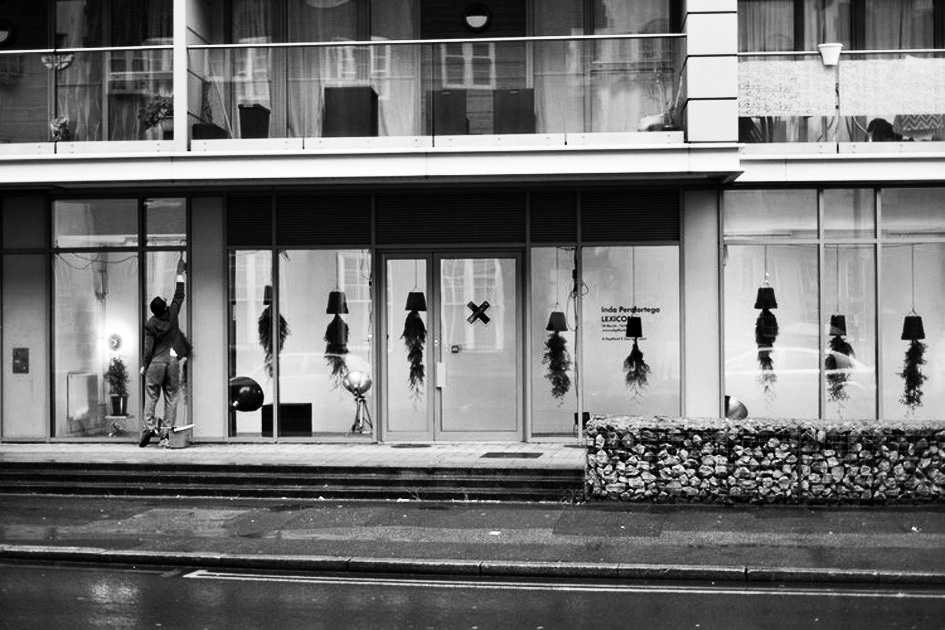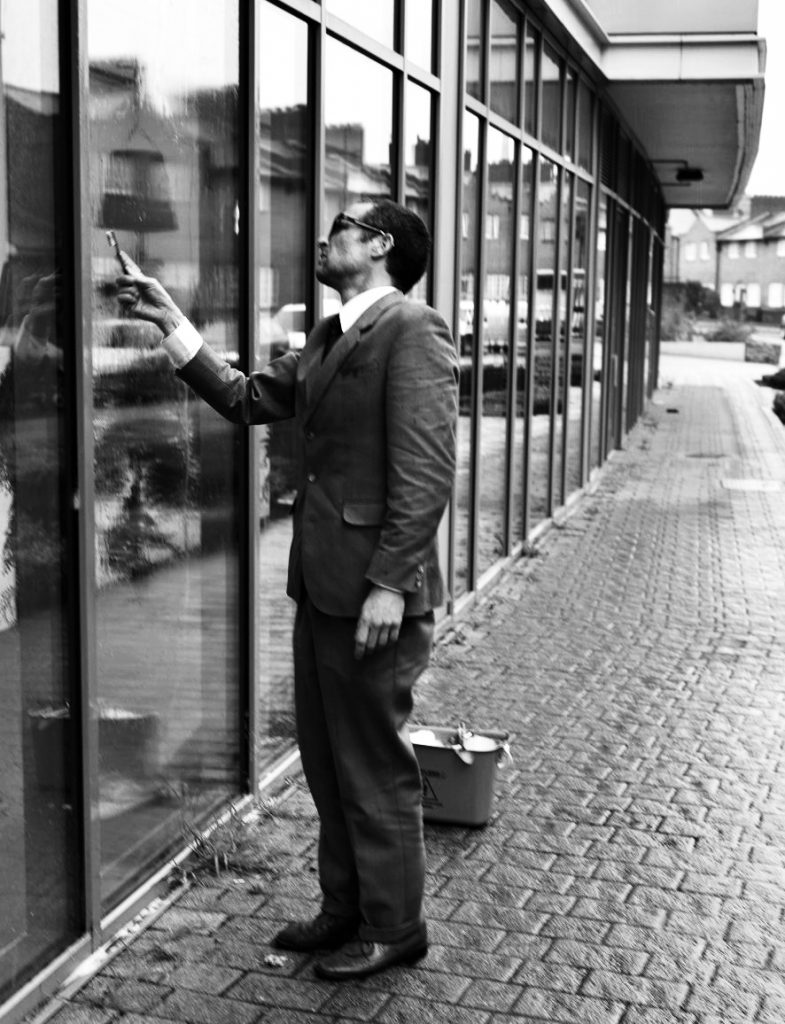A Queer Bend in the Botanical Turn
Inda Peralortega: Lexicon
Deptford X, London
18.03.16 – 14.05.16
In the language of art criticism ‘turns’ appear to have replaced ‘isms’ as the principle terminology for gathering diverse practices into more or less intelligible trends. If the tag ‘The Botanical Turn’ has not yet been coined, the growing interest of artists and curators in exploring various ways of incorporating non-human living matter into exhibition spaces suggests it may soon become prevalent. Compelled in part by the need to address society’s impact on the ecosystems that support us, the art world has become increasingly concerned with ‘culture’s’ relationship to ‘nature’, resulting in plants popping up in a multitude of white cubes and museums throughout the international art scene. In comparison to Abraham Cruzvillegas’ installation, Empty Lot, at Tate Modern, probably 2015–16’s most ambitious and large-scale attempt to repurpose the gallery as greenhouse, Lexicon, the first solo show of recent Goldsmiths graduate Inda Peralortega, was a remarkably humble, but strangely moving affair. In Deptford X’s new street-level vitrine-style gallery, twenty young Conifer brabantia pine trees hung upside down in the glare of grow lights for the two months’ duration of the exhibition, while a lone sibling, or clone, stood at one end of the space, proudly upright on a small Perspex box.
Since it is in the nature of nature to exist in a state of perpetual change, and for vegetation this flux is notably unhurried, the inclusion of living plants in exhibitions inevitably induces a decelerated fascination with flora’s slow theatrics. In order to attune to variations occurring at this speed, viewers ( at least this one ) are coaxed into a kind of temporal dilation, a certain style of meditative wonderment; displaced from the digitally conditioned immediacy of contemporary life we are required to pause, then forced to wait. In this predicament, questions abound. If the uncertainty around if, when and what might grow accompanied viewing the myriad triangular containers in the Hyundai-commissioned Tate Modern show, Lexicon elicited attention by triggering a less taxonomic curiosity: not a question of what, but one of how will these trees grow? And, if the eventual emergence of a few weeds in the vast Turbine Hall was something of an anticlimax, perhaps this indicates that the ‘what?’ of things has been somewhat exhausted, and Tino Sehgal is prescient when he posits: ‘I think the twenty-first century will hopefully be more guided by “how” questions…’ Approaching the botanical turn with this insight we may choose to ask, not ‘What grows in your garden?’ so much as, in the words of the popular English nursery rhyme, ‘How does your garden grow?’
As an instance of this new art-verdure, Peralortega’s rotating and framing of twenty trees behind a bank of glass on a busy street staged a fertile intervention into the fabric of the city. The initial visual impact offered by the spectacle of hanging conifers was, while arresting, but a precursor to further rumination, as the work, like all good art, rewarded sustained attention. Over the course of the eight weeks on show, the upended saplings in Lexicon, fed and watered daily, continued to grow and, eventually displayed a curious, though not completely unexpected movement: they began to bend. With their ‘natural’ orientation reversed, roots directed skyward, green tips pointing down, the evergreens, in their own leisurely measure, gently turned. This was a subtle and slow, but unmistakably queer, performance. And how strange, and quite contrary it was! As contemporary city dwellers we are used to passing a variety of plants in the urban environment without much thought as to what they might be able to tell us, so what an uncanny experience to feel addressed by these conifers, to have the sense that these mute trees have something to say. As consumers of art, we are primed to probe images, objects and experiences for meaning. Even so, in encountering the work this viewer was unprepared for the unsettling awareness of being performed to by something as apparently familiar and dumb as a row of trees.
So what to make of this upside-down, collective bow and its disturbance of Cartesian axes? If we take the title of the exhibition as a guide, this deviation from straightness is presented as operating within a particular kind of vocabulary. But clearly, since the trees cannot speak, and the exhibition offered no accompanying text, here the vernacular is not a catalogue of linguistic signs so much as a gesture in the lexicon of bodies. Beside and between the dominant semantic discourse, queerness communicates in the artful comportment of soma. Despite being inserted into something like a white cube, a privileged site in the production of concepts, these life forms remained fundamentally bound to the corporeal logics of light, nutrition and gravity. And our ability to relate to them reminds us ( in my case, inducing a certain shiver of surprise ) that this is how it should be. These trees-as-work-of-art appeal, not simply to be ‘read’ conceptually, but to be experienced by our own sensual bearing and movement in physical space. Observed from the pavement in this way, the green shapes behind glass appeared more suggestive, the sound of traffic more musical, and the extravagant motion of the city relentlessly alive.
Encompassing the sounds and swing of the street, the locality and its architecture thus played a crucial role. Housed on the ground floor of a new and typically insensitive, flat, grey apartment building, Deptford X’s space functioned as an antithetic enclosure for the organic matter inside, the strict grid arcade acting as formal backdrop for the swerve of green. Somewhere between gallery and public site the vitrine allows for a particular manner of viewing: twenty-four hours a day, anyone can look. A spectacle presented in this fashion is available equally to denizens of the art world and casual passers-by. Lexicon, however, due to the eloquence of its durational inflection, addressed itself most directly and intimately to regular users of the street, the gradual bending of the trees unfolding most apparently to those frequently walking or driving by on their way to and from school, home or work. Overturning the particular and persistent whiff of elitism and exclusivity that surrounds much contemporary art is no mean feat, and this levelling manoeuvre echoed loudly in the single, and singular, performance Peralortega staged to accompany the exhibition. Over several hours on a grey afternoon, dressed in sharp business suit and patent leather shoes, the artist proceeded carefully to clean the gallery’s long swathe of glass with squeegee, bucket and toothbrush. Without publicity or fanfare, this odd worker appeared anomalously like a slightly deranged, but curiously diligent, executive: a banker, perhaps, reduced by circumstance or choice ( who could tell? ) to the role of humble window cleaner. As Bakhtin writes of the lost tradition of carnival: ‘Everything here is inverted in relation to the outside world. All who are highest are debased, all who are lowest are crowned.’ With this peculiar act interposed into a prosaic road in south-east London the scene was suffused with an odd conflation of mundanity and theatre, a specific strain of deeply contemporary and demented normality. And the cars passed endlessly by, coughing out carbon.
Lexicon is not the first time trees have been upturned in the name of contemporary art. In 2009 Gustav Metzger realised Flailing Trees, a major public commission, as part of the Manchester International Festival. The work consisted of twenty-one ( curiously, the same number as in Lexicon ) willows, planted in several tons of cement, with their roots helplessly exposed and scrawled in the air, like a threat. Scrutinising the differences between the two installations perhaps gives us clues as to a crucial shift in attitude percolating through contemporary theory and practice. Metzger’s trees, dead, static and interred in a cubic block of modernist concrete, appear most plainly, and somewhat didactically perhaps, as a comment on society’s effects on the natural world. In contrast, Lexicon, nourished by questions of how we orientate ourselves in relation to extra-human life, rather than what damage we might do to it, seems to confer potential for other, possibly queerer, entanglements of human and non-human bio-politics. The revelation of life’s ingrained capacity to divert from the norm suggests often hard-to-imagine futures. Here the trees are inverted, but still vital, sensing light and performing a slow turn in the hectic, hyper-modern metropolis; an invitation to rethink the familiar, to suspend the rush of thought in sensation, and perhaps bend too.
一个“植物学转向”中的诡异弯曲
Inda Peralortega个展:“辞典”
狄普福X艺术中心,伦敦
2016年3月18日 – 2016年5月14日
在艺术批评的语言中,“转向”( turns )似乎替代了“主义”( isms )成为一个主要的术语,将不同的实践都汇聚到大约易懂的趋势中。如果“植物学转向”( The Botanical Turn )一词尚未被发明,那么至少,艺术家和策展人们都有着与日俱增的兴趣去探索如何将非人类的生命物质纳入到展览空间,因此这个术语也很快就会流行起来。社会对于支持我们的生态系统施有何种影响金部分地出于提醒人们注意这一问题的需要,艺术界在越来越多地关注“文化”与“自然”之间的关系,而其结果就是,纵观国际艺术的图景,我们会看到植物越来越多地涌现在各种白盒子和美术馆的空间中。亚伯拉罕克鲁兹威力戈斯( Abraham Cruzvillegas )在泰特现代艺术馆的装置作品《空地》,或许是2015到2016年度里最富野心并且体量最大的、将展览空间重置为温室的尝试。与之相比,来自金匠学院( Goldsmiths )新近毕业生Inda Peralortega的第一次个展“辞典”则非常谦逊含蓄,但又奇异地让人受到触动。在狄普福X艺术中心( Deptford X )崭新的玻璃橱窗式临街画廊里,二十棵年轻的松树,确切来说是布拉邦蒂亚针叶树( Conifer Brabantia ),在两个月的展览期间被上下颠倒着悬挂在炫目的灯光中。另有一棵同类的树,或者可能是一株克隆树,孤独地站在空间的另一头,它骄傲地直立在一个小小的有机玻璃盒子中。
自然的天性就是生存在一个恒久变动的状态之中,而对植物来说,这种变动看起来不慌不忙。有鉴于此,将活生生的植物囊括到展览当中就不可避免地会引起对于植物那种缓慢的视觉效果所产生的递减的迷恋。为了与如此缓慢速度带来的变化相匹配,( 至少这个展览中的 )观众们会被诱导着进入一种时间上的扩展,就像某种特定的冥想奇观那样;当代生活数字化条件带来的即时性被取而代之,我们被迫停留,然后被迫等待。在这样的状态中,问题接踵而至。如果在观看由现代汽车委托的泰特展览中那无数个三角形的容器时,会让人围绕着“如果”、“何时”、“什么”生发出不确定之感,那么展览“辞典”则通过触动一种在分类学意义上较少好奇之心的问题来引起人们的注意:这个问题无关“什么”,而在于提问,这些树将会如何生长呢?此外,如果在巨大的涡轮大厅里最终出现的那些杂草可以被视作一件反高潮的事,那么或许这就在表达着“什么”的提问。是什么样的事物已经被耗尽枯竭了?当提诺塞格尔( Tino Sehgal )说“我认为二十一世纪将充满希望地被更多‘怎样’的问题所引领”之时,他在这方面显出了先见之明。带着这样的洞见来着手处理“植物学转向”,我们可以选择发问的不再是诸如“你的花园里种了什么”这样的问题,而是就像广为人知的那首英语童谣所唱的一样金“你的花园生长得怎样”。

Inda Peralortega, Lexicon, 2016. Photo: Patrick Henry. Inda Peralortega个展:“辞典”( 2016 ),图片: Patrick Henry.
作为这种新兴的“绿色植被艺术”( art-verdure )的一个例子,Peralortega将二十棵树反转着置于繁忙街道的玻璃橱窗之后,是对这座城市的肌理建构起了一种丰茂肥沃的介入。倒挂针叶树的景象所带来的第一视觉印象尽管抓人眼球,但也只是更深入沉思的一个开端,因为就像所有好的艺术那样,这件作品赢得了持续的关注。在展览的八周时间里,“辞典”中倒立的树苗每天都被施肥浇水,它们持续生长,并且最终呈现出一种让人好奇的,但也并非完全出乎意料的运动:它们开始弯曲。由于它们“自然”的生长方向被倒转,根部直指天空,而绿叶朝向地面,这些常青树用自己从容的度量方式平缓地进行逆转。这是一场微妙而又缓慢,但也毫无疑问非常诡异的表演。况且,这一切是多么的奇怪,并且逆反啊!作为当代城市的居住者,我们都习惯了路过城市景观中各种各样的植物,而不会去想它们或许能够告诉我们一些什么,所以这些针叶树所带来的体验是不可思议的,它们让人觉得哑口无言的树其实有话要说。作为艺术的消费者,我们常常整装待发地去探查图像、物件和经验中的意义。即便如此,在看到这件作品时,观看者也未必做好了全然的准备,他们不会想到像一排树这样如此熟悉且愚蠢的东西会展示出这样令人不安的意识。
那么,该如何看待这种上下颠倒、集体性的弯曲、以及它们对于笛卡尔坐标轴的扰动呢?如果我们将展览的标题视作指引,这种脱离横平竖直的偏差,是被作为一种对于具体词汇的处理来进行展示的。不过显而易见的是,因为树并不能说话,而且展览也没有提供相关的文字资料,那么这里所说的语言就并不是语言学符号中的一种分类,也并非肢体语言中的那些手势姿态。在主流的语义学话语之侧和之间,诡异性( queerness )用一种体细胞( soma )带有艺术气质的举止动作来进行交流。尽管被安插到了类似于白盒子那样在概念生产方面享有特权的空间当中,这些生命形式仍然保留着非常基本的光照、营养和重力的物质逻辑。而我们与它们产生关联的能力,则提醒着我们( 于我而言还带来了惊喜 ),这本是它应该的样子。这些作为艺术作品的树的吸引力,不在于被简单地运用观念来“解读”,而在于通过我们自己的感官以及在物理空间当中的运动来体验它们。在这样的方式之下,站在人行道的角度观察这件装置,看着那些在玻璃之后的绿色形状,似乎还有更多的暗示,人流交通的声音变得更像乐音,而城市里狂热的动态则显出不屈不挠的活力。
被街道的声音和摆动所包围,展览的“在地性”( locality )及其建筑因而扮演了至关重要的角色。狄普福X艺术中心坐落在一幢崭新的、典型的、不起眼而又平直的灰色公寓楼的底层,这处密闭空间发挥着与其内部的有机事物相对立的功能;有着严谨网格的拱廊成为扭曲着的绿色植物的一片非常正式的背景。在画廊与公共区域之间的玻璃橱窗,则允许了一种特定的观看方式:每一天的二十四小时当中,任何人都能看见。这种方式所呈现的景象,对于艺术界的人士和闲散经过的路人而言是同样平等的。不过,有鉴于展览持续期间产生的变化所带来的丰富视觉,展览“辞典”对于经常路过这条街的人而言会更加直接相关而又亲切。树木日渐的弯曲,这对于那些往返于学校、家或工作之间的行人和车辆来说是最为鲜明的。破坏了围绕在许多当代艺术身上精英主义和排他性所带来的那种特别而持久的气息,并不是什么刻意而为的功绩,而这背后的策略又与艺术家Peralortega为配合展览而进行的唯一一次单人的行为表演有着响亮的呼应。在一个灰蒙蒙的午后,艺术家穿着笔挺的西装和锃亮的皮鞋,拿着刮刀、水桶和牙刷,仔仔细细地为画廊长长的玻璃橱窗进行了数个小时的清洁工作。这场表演没有任何宣传或是刻意制造的粉丝效应,使得这位古怪的人看起来就像一个有轻微精神错乱但又无比勤奋的公司执行高管,或者是个什么银行家,因为受制于某些情况或出于个人选择( 谁知道呢? )而将角色转换成了谦卑的擦窗工人。正如巴赫金( Bakhtin )对丢失了传统的狂欢节的感慨,‘这里的每一件事都受到外部世界的关联而被反转。所有那些高高在上的人都受到了贬损,而所有那些底层的人则喜获冠冕’。这出剧目在伦敦东南部一条平淡无奇的街道上演,整个场景充斥着一种日常与戏剧、深植于当代的压力与癫狂错乱的常态的奇异混杂。而路边的汽车,一边向外喷出碳化物质,一边不断地往来经过。

Inda Peralortega, Lexicon, 2016. Photo: Patrick Henry. Inda Peralortega个展:“辞典”( 2016 ),图片: Patrick Henry.
展览“辞典”并不是树木第一次以当代艺术的名义被颠倒呈现。2009年时,古斯塔夫梅茨格( Gustav Metzger )完成了作品《连枷的树》,是他为当时曼彻斯特国际艺术节委任制作的一件大型公共艺术装置。作品包括了二十一棵( 好奇怪,居然和“辞典”中树木的数量一样 )待在几吨水泥当中的柳树,它们的根部无助地曝露在外,并且像是一种威胁那样潦潦草草地冲着天空。仔细地研究这两件装置作品的不同之处,或许能向我们提供一些观察当代理论与实践中所渗透的一种重要的态度变化的线索。梅茨格的树是死亡的,静止不动的,并且被埋葬在一块混凝土材质的现代主义立方体中,看起来极为直白而又带着说教地点评着社会对于自然界施加的影响。
与之相反,通过问题的补给滋养,即,发问我们怎样在与人类之外生命的关系中进行自我定位,而并非我们可能对它们造成什么样的破坏,“辞典”似乎将潜在的可能赋予了他者,还有那些或许更加诡异的、人类与非人类生物政治之间的缠绕牵连。生命能够偏离常态,这种根深蒂固的能力显示出了不可想象的未来。在这里,树木被倒置,但仍然充满活力,它们能够感知光线,并且在狂热而超现代的大都会中上演缓慢的反转;它们邀请我们重新思考那些人们熟知的事物,暂停在那些感官中匆忙的想法之中,可能还有事关弯曲的想法吧。